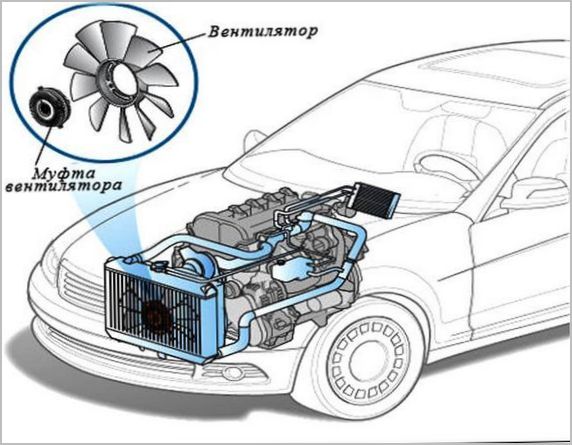
The role of the fan in liquid cooling
Content
The transfer of heat generated during operation of the motor to the atmosphere requires constant blowing of the radiator of the cooling system. The intensity of the oncoming high-speed air flow is not always sufficient for this. At low speeds and full stops, a specially designed additional cooling fan comes into play.
Schematic diagram of air injection into the radiator
It is possible to ensure the passage of air masses through the honeycomb structure of the radiator in two ways - to force air along the direction of the natural flow from the outside or to create a vacuum from the inside. There is no fundamental difference, especially if a system of air shields - diffusers is used. They provide a minimum flow rate for useless turbulence around the fan blades.

Thus, there are two typical options for organizing blowing. In the first case, the fan is located on the engine or radiator frame in the engine compartment and creates a pressure flow to the engine, taking air from outside and passing it through the radiator. To prevent the blades from running idle, the space between the radiator and the impeller is closed as tightly as possible with a plastic or metal diffuser. Its shape also promotes the use of maximum honeycomb area, since the fan diameter is usually much smaller than the geometrical dimensions of the heatsink.
When the impeller is located on the front side, the fan drive is possible only from an electric motor, since the radiator core prevents mechanical connection with the engine. In both cases, the chosen shape of the heat sink and the required cooling efficiency may force the use of a double fan with smaller diameter impellers. This approach is usually accompanied by a complication of the operation algorithm, the fans are able to be switched separately, adjusting the airflow intensity depending on the load and temperature.
The fan impeller itself can have a rather complex and aerodynamic design. It has a number of requirements:
- the number, shape, profile and pitch of the blades should ensure minimal losses without introducing additional energy costs for useless grinding of air;
- in a given range of rotation speeds, flow stall is excluded, otherwise the drop in efficiency will affect the thermal regime;
- the fan must be balanced and not create both mechanical and aerodynamic vibrations that can load bearings and adjacent engine parts, especially thin radiator structures;
- the noise of the impeller is also minimized in line with the general trend of reducing the acoustic background produced by vehicles.
If we compare modern car fans with primitive propellers half a century ago, then we can note that science has worked with such fairly obvious details. This can be seen even externally, and during operation, a good fan almost silently creates an unexpectedly powerful air pressure.
Fan drive types
Creating an intense air flow requires a significant amount of fan drive power. Energy for this can be taken from the engine in various ways.
Continuous rotation from a pulley
In the early simplest designs, the fan impeller was simply put on the water pump drive belt pulley. Performance was provided by the impressive diameter of the circumference of the blades, which were simply bent metal plates. There were no noise requirements, the nearby old engine muffled all sounds.
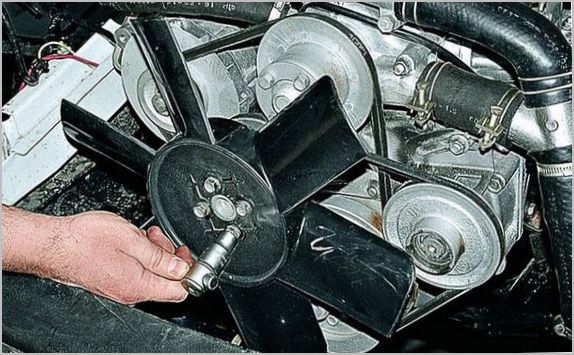
The speed of rotation was directly proportional to the revolutions of the crankshaft. A certain element of temperature control was present, because with an increase in the load on the engine, and hence its speed, the fan also began to drive air through the radiator more intensively. Deflectors were rarely installed, everything was compensated by oversized radiators and a large volume of cooling water. However, the concept of overheating was well known to the drivers of the time, being the price to pay for simplicity and lack of thought.
Viscous couplings
Primitive systems had several disadvantages:
- poor cooling at low speeds due to the low speed of the direct drive;
- with an increase in the size of the impeller and a change in the gear ratio to increase the airflow at idle, the motor began to supercool with increasing speed, and the fuel consumption for the stupid rotation of the propeller reached a significant value;
- while the engine was warming up, the fan continued to stubbornly cool the engine compartment, performing exactly the opposite task.
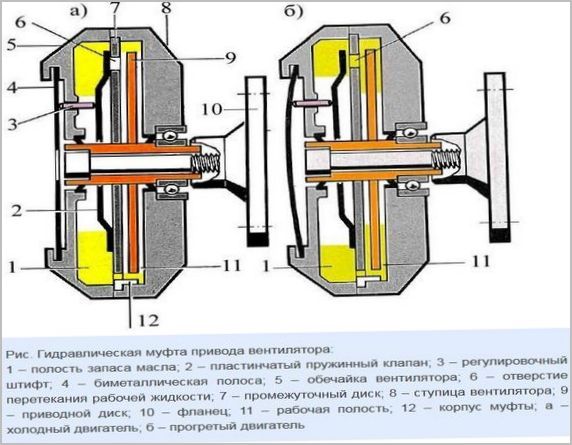
It was clear that further increases in engine efficiency and power would require fan speed control. The problem was solved to some extent by a mechanism known in the art as a viscous coupling. But here it must be arranged in a special way.
The fan clutch, if we imagine it in a simplified way and without taking into account various versions, consists of two notched disks, between which there is a so-called non-Newtonian fluid, that is, silicone oil, which changes viscosity depending on the relative movement speed of its layers. Up to a serious connection between the disks through a viscous gel into which it will turn. It remains only to place a temperature-sensitive valve there, which will supply this liquid into the gap with an increase in engine temperature. A very successful design, unfortunately, not always reliable and durable. But often used.
The rotor was attached to a pulley rotating from the crankshaft, and an impeller was put on the stator. At high temperatures and high speeds, the fan produced maximum performance, which was required. Without taking away excess energy when airflow is not needed.
Magnetic clutch
In order not to suffer with chemicals in the coupling that are not always stable and durable, a more understandable solution from an electrical engineering point of view is often used. The electromagnetic clutch consists of friction discs that are in contact and transmit rotation under the action of a current supplied to the electromagnet. The current came from a control relay that closed through a temperature sensor, usually mounted on a radiator. As soon as insufficient airflow was determined, that is, the liquid in the radiator overheated, the contacts closed, the clutch worked, and the impeller was spun by the same belt through the pulleys. The method is often used on heavy trucks with powerful fans.
direct electric drive
Most often, a fan with an impeller directly mounted on the motor shaft is used on passenger cars. The power supply of this motor is provided in the same way as in the described case with an electric clutch, only a V-belt drive with pulleys is not required here. When necessary, the electric motor creates airflow, turning off at normal temperature. The method was implemented with the advent of compact and powerful electric motors.
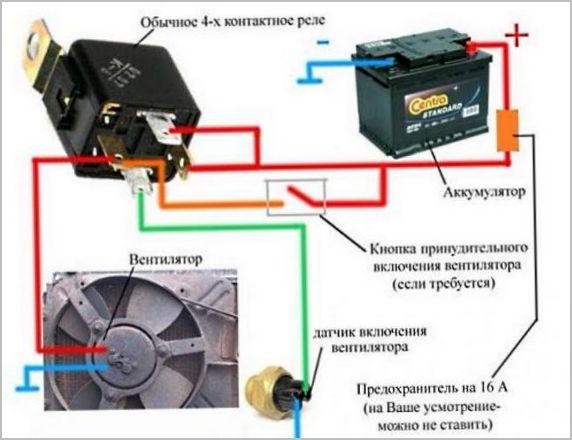
A convenient quality of such a drive is the ability to work with the engine stopped. Modern cooling systems are heavily loaded, and if the airflow stops abruptly, and the pump does not work, then local overheating is possible in places with a maximum temperature. Or boiling gasoline in the fuel system. The fan may run for a while after stopping to prevent problems.
Problems, malfunctions and repairs
Turning on the fan can already be considered an emergency mode, since it is not the fan that regulates the temperature, but the thermostat. Therefore, the forced airflow system is made very reliably, and it rarely fails. But if the fan does not turn on and the motor boils, then the parts most susceptible to failure should be checked:
- in a belt drive, the belt may loosen and slip, as well as its complete breakage, all this is easy to determine visually;
- the method for checking the viscous coupling is not so simple, but if it slips heavily on a hot engine, then this is a signal for replacement;
- electromagnetic drives, both the clutch and the electric motor, are checked by closing the sensor, or on the injection motor by removing the connector from the temperature sensor of the engine control system, the fan should start rotating.
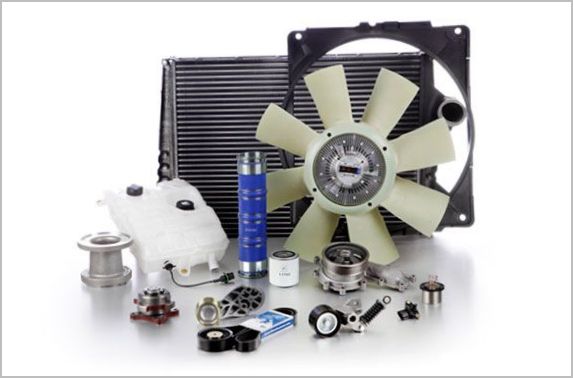
A faulty fan can destroy the engine, because overheating is fraught with a major overhaul. Therefore, it is impossible to drive with such defects even in winter. Failed parts should be replaced immediately, and only spare parts from a reliable manufacturer should be used. The price of the issue is the engine, if it is driven by temperature, then repairs may not help. Against this background, the cost of a sensor or an electric motor is simply negligible.
